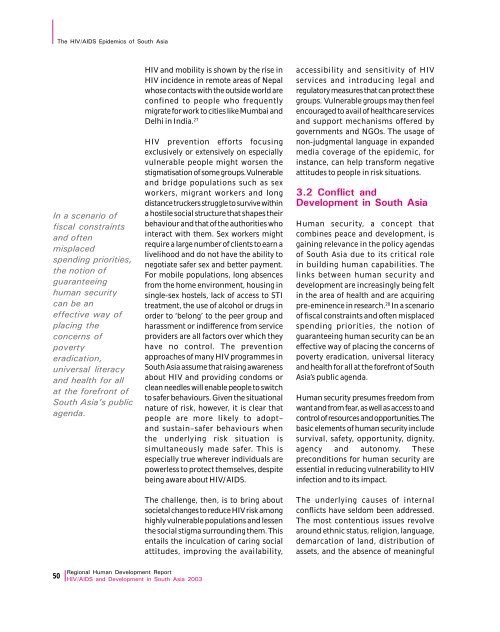Download Report - UNDP Asia-Pacific Regional Centre - United ...
Download Report - UNDP Asia-Pacific Regional Centre - United ...
Download Report - UNDP Asia-Pacific Regional Centre - United ...
You also want an ePaper? Increase the reach of your titles
YUMPU automatically turns print PDFs into web optimized ePapers that Google loves.
The HIV/AIDS Epidemics of South <strong>Asia</strong>In a scenario offiscal constraintsand oftenmisplacedspending priorities,the notion ofguaranteeinghuman securitycan be aneffective way ofplacing theconcerns ofpovertyeradication,universal literacyand health for allat the forefront ofSouth <strong>Asia</strong>’s publicagenda.HIV and mobility is shown by the rise inHIV incidence in remote areas of Nepalwhose contacts with the outside world areconfined to people who frequentlymigrate for work to cities like Mumbai andDelhi in India. 27HIV prevention efforts focusingexclusively or extensively on especiallyvulnerable people might worsen thestigmatisation of some groups. Vulnerableand bridge populations such as sexworkers, migrant workers and longdistance truckers struggle to survive withina hostile social structure that shapes theirbehaviour and that of the authorities whointeract with them. Sex workers mightrequire a large number of clients to earn alivelihood and do not have the ability tonegotiate safer sex and better payment.For mobile populations, long absencesfrom the home environment, housing insingle-sex hostels, lack of access to STItreatment, the use of alcohol or drugs inorder to ‘belong’ to the peer group andharassment or indifference from serviceproviders are all factors over which theyhave no control. The preventionapproaches of many HIV programmes inSouth <strong>Asia</strong> assume that raising awarenessabout HIV and providing condoms orclean needles will enable people to switchto safer behaviours. Given the situationalnature of risk, however, it is clear thatpeople are more likely to adopt–and sustain–safer behaviours whenthe underlying risk situation issimultaneously made safer. This isespecially true wherever individuals arepowerless to protect themselves, despitebeing aware about HIV/AIDS.The challenge, then, is to bring aboutsocietal changes to reduce HIV risk amonghighly vulnerable populations and lessenthe social stigma surrounding them. Thisentails the inculcation of caring socialattitudes, improving the availability,accessibility and sensitivity of HIVservices and introducing legal andregulatory measures that can protect thesegroups. Vulnerable groups may then feelencouraged to avail of healthcare servicesand support mechanisms offered bygovernments and NGOs. The usage ofnon-judgmental language in expandedmedia coverage of the epidemic, forinstance, can help transform negativeattitudes to people in risk situations.3.2 Conflict andDevelopment in South <strong>Asia</strong>Human security, a concept thatcombines peace and development, isgaining relevance in the policy agendasof South <strong>Asia</strong> due to its critical rolein building human capabilities. Thelinks between human security anddevelopment are increasingly being feltin the area of health and are acquiringpre-eminence in research. 28 In a scenarioof fiscal constraints and often misplacedspending priorities, the notion ofguaranteeing human security can be aneffective way of placing the concerns ofpoverty eradication, universal literacyand health for all at the forefront of South<strong>Asia</strong>’s public agenda.Human security presumes freedom fromwant and from fear, as well as access to andcontrol of resources and opportunities. Thebasic elements of human security includesurvival, safety, opportunity, dignity,agency and autonomy. Thesepreconditions for human security areessential in reducing vulnerability to HIVinfection and to its impact.The underlying causes of internalconflicts have seldom been addressed.The most contentious issues revolvearound ethnic status, religion, language,demarcation of land, distribution ofassets, and the absence of meaningful50<strong>Regional</strong> Human Development <strong>Report</strong>HIV/AIDS and Development in South <strong>Asia</strong> 2003
















